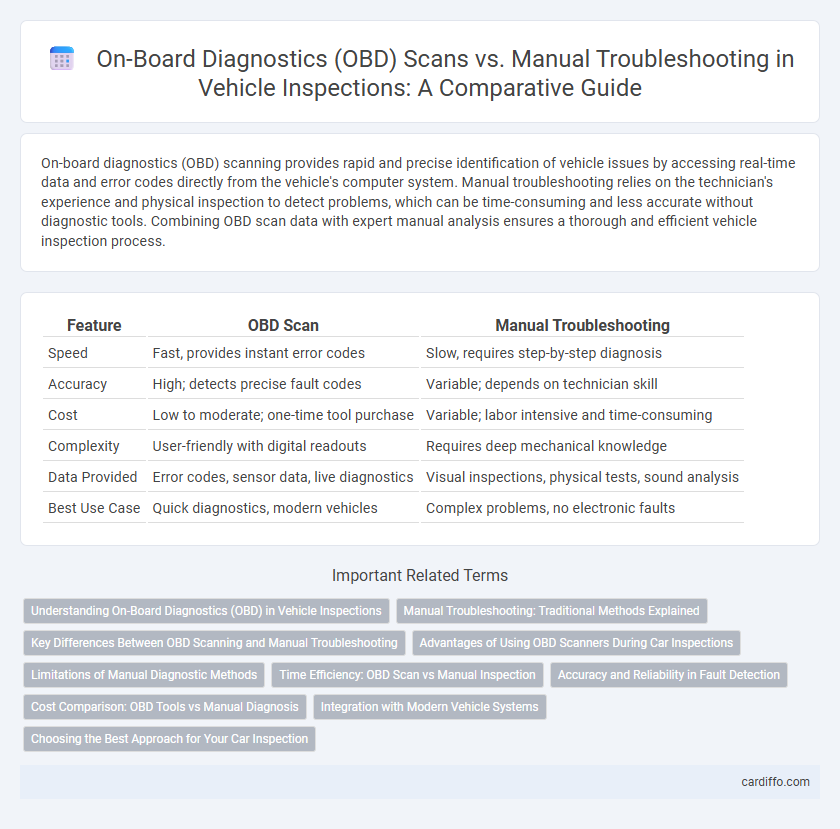On-board diagnostics (OBD) scanning provides rapid and precise identification of vehicle issues by accessing real-time data and error codes directly from the vehicle's computer system. Manual troubleshooting relies on the technician's experience and physical inspection to detect problems, which can be time-consuming and less accurate without diagnostic tools. Combining OBD scan data with expert manual analysis ensures a thorough and efficient vehicle inspection process.
Table of Comparison
| Feature | OBD Scan | Manual Troubleshooting |
|---|---|---|
| Speed | Fast, provides instant error codes | Slow, requires step-by-step diagnosis |
| Accuracy | High; detects precise fault codes | Variable; depends on technician skill |
| Cost | Low to moderate; one-time tool purchase | Variable; labor intensive and time-consuming |
| Complexity | User-friendly with digital readouts | Requires deep mechanical knowledge |
| Data Provided | Error codes, sensor data, live diagnostics | Visual inspections, physical tests, sound analysis |
| Best Use Case | Quick diagnostics, modern vehicles | Complex problems, no electronic faults |
Understanding On-Board Diagnostics (OBD) in Vehicle Inspections
On-board diagnostics (OBD) systems provide real-time data and standardized diagnostic trouble codes (DTCs) that streamline vehicle inspections by quickly identifying engine and emission system faults. Manual troubleshooting relies on technician experience and visual inspection but is time-consuming and prone to human error, making it less efficient than OBD scanning tools. Integrating OBD scan results allows for precise fault detection, enhanced accuracy, and compliance with environmental regulations during vehicle inspections.
Manual Troubleshooting: Traditional Methods Explained
Manual troubleshooting in vehicle inspections involves systematically checking mechanical and electrical components without relying on diagnostic tools. Technicians use visual inspections, physical tests, and sensor analysis to identify faults, drawing on experience and knowledge of automobile systems. This method allows for detecting issues that may not immediately trigger OBD codes, ensuring a comprehensive assessment of vehicle health.
Key Differences Between OBD Scanning and Manual Troubleshooting
OBD scanning provides real-time, precise diagnostic codes directly from the vehicle's onboard computer, enabling faster identification of faults compared to manual troubleshooting, which relies on visual inspection and experience. Manual troubleshooting often requires physical access to components and step-by-step testing, making it more time-consuming and prone to human error. OBD scanners enhance accuracy by accessing standardized diagnostic trouble codes (DTCs), while manual methods excel in diagnosing issues outside the computer's scope such as wiring and mechanical faults.
Advantages of Using OBD Scanners During Car Inspections
Using On-board diagnostics (OBD) scanners during car inspections significantly reduces diagnostic time by quickly identifying error codes related to engine performance, emissions, and electronic systems. OBD scanners provide precise, real-time data that enhances accuracy compared to manual troubleshooting, minimizing human error and guesswork. This technology also enables technicians to efficiently monitor system health and track intermittent issues, improving overall vehicle maintenance and safety compliance.
Limitations of Manual Diagnostic Methods
Manual diagnostic methods often suffer from limited accuracy and efficiency due to reliance on technician expertise and subjective interpretation of symptoms. These methods lack real-time data access, making it difficult to pinpoint intermittent or complex faults in vehicle systems. In contrast, on-board diagnostics (OBD) scans provide precise, standardized error codes and live sensor data that significantly enhance fault detection and repair accuracy.
Time Efficiency: OBD Scan vs Manual Inspection
OBD scan drastically reduces diagnostic time by quickly retrieving error codes and system data from the vehicle's computer, allowing technicians to pinpoint issues within minutes. Manual troubleshooting requires extensive physical inspection and testing of each component, often leading to longer diagnostic sessions and increased labor costs. The time efficiency of OBD scanning enhances workflow productivity and accelerates vehicle repair turnaround compared to traditional manual inspection methods.
Accuracy and Reliability in Fault Detection
On-board diagnostics (OBD) scans provide precise fault codes directly from the vehicle's computer system, enhancing accuracy in detecting issues compared to manual troubleshooting. Manual methods rely heavily on technician experience and visual inspection, which can lead to missed or misinterpreted faults. OBD systems improve reliability by continuously monitoring vehicle performance and offering real-time data that manual checks cannot consistently replicate.
Cost Comparison: OBD Tools vs Manual Diagnosis
On-board diagnostics (OBD) scans significantly reduce labor costs by quickly identifying engine faults through automated data retrieval, whereas manual troubleshooting often requires extensive diagnostic time and expertise, increasing labor expenses. The initial investment in OBD tools can be higher, but the long-term savings in diagnostic efficiency and reduced vehicle downtime outweigh the upfront costs. Manual diagnosis may incur additional indirect costs due to prolonged troubleshooting periods and potential misdiagnosis, highlighting the economic advantages of OBD technology in vehicle inspections.
Integration with Modern Vehicle Systems
On-board diagnostics (OBD) scan tools seamlessly integrate with modern vehicle systems by accessing standardized communication protocols like CAN and UDS, enabling quick detection of fault codes and real-time data monitoring. Manual troubleshooting, while valuable for complex or atypical faults, often lacks direct interface with advanced electronic control units (ECUs) and requires extensive technical knowledge and time. The OBD system's ability to interface with hybrid, electric, and autonomous vehicle components ensures more efficient diagnostics compared to traditional manual methods.
Choosing the Best Approach for Your Car Inspection
On-board diagnostics (OBD) scans provide accurate, real-time data on your vehicle's engine performance, emissions, and electronic systems, enabling quick identification of error codes and malfunctions. Manual troubleshooting involves hands-on inspection and often requires expert knowledge to interpret symptoms and perform physical tests, which can uncover issues that scanners may not detect. Choosing the best approach for a car inspection depends on the complexity of the problem, with OBD scans offering efficiency for common faults and manual troubleshooting being essential for comprehensive diagnosis and repair.
On-board diagnostics (OBD) scan vs manual troubleshooting Infographic

 cardiffo.com
cardiffo.com